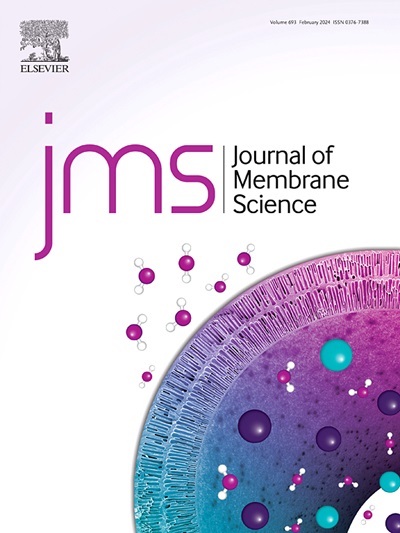Highly alkali stable poly(biphenyl-piperidine-isatin) anion exchange membranes with grafted quinuclidine side chains
IF 8.4
1区 工程技术
Q1 ENGINEERING, CHEMICAL
引用次数: 0
Abstract
As the core component of fuel cells, anion-exchange membranes (AEMs) must possess high alkali resistance and excellent ionic conductivity, as these properties significantly influence the durability and performance of fuel cells. In this study, an AEM based on biphenyl-isatin-piperidine main chain was designed and prepared. The synergistic optimization of ionic conductivity, alkali stability and mechanical properties was achieved by grafting the prepared novel long alkyl-spaced quinuclidine side chains. The incorporation of quinuclidine side chains improving membranes microphase separation and broadening the ionic transport channels, and the conductivity of QPBIP-QC-10 reached 144.5 mS cm−1 at 80 °C. The quinuclidine cyclic cations in the membranes showed little degradation after 2000 h of alkali resistance testing in 3 M NaOH aqueous solution at 80 °C, with conductivity retention exceeding 90 %, demonstrating the stability of the QPBIP-QC-x series membranes. The cell assembled from PBIP-QC-10 achieved a peak power density of 517.3 mW cm−2. Furthermore, the QPBIP-QC-10 membrane exhibited 85 % retention of its initial voltage after a 30 h durability test at 80 °C and 0.1 A cm−2.
具有接枝喹啉侧链的高碱稳定性聚(联苯-哌啶-isatin)阴离子交换膜
阴离子交换膜(AEMs)作为燃料电池的核心部件,必须具有较高的耐碱性和优异的离子电导率,这些性能对燃料电池的耐久性和性能有重要影响。本研究设计并制备了以联苯- istin -哌替啶为主链的AEM。通过接枝所制备的新型长烷基间距喹啉侧链,实现了离子电导率、碱稳定性和力学性能的协同优化。喹啉侧链的加入改善了膜的微相分离,拓宽了离子传输通道,QPBIP-QC-10在80℃时的电导率达到144.5 mS cm−1。在80°C的3 M NaOH水溶液中耐碱性测试2000 h后,膜中的喹啉环阳离子几乎没有降解,电导率保持率超过90%,证明了QPBIP-QC-x系列膜的稳定性。由PBIP-QC-10组装的电池达到了517.3 mW cm−2的峰值功率密度。此外,QPBIP-QC-10膜在80°C和0.1 a cm - 2条件下经过30小时的耐久性测试后,其初始电压保持率为85%。
本文章由计算机程序翻译,如有差异,请以英文原文为准。
求助全文
约1分钟内获得全文
求助全文
来源期刊

Journal of Membrane Science
工程技术-高分子科学
CiteScore
17.10
自引率
17.90%
发文量
1031
审稿时长
2.5 months
期刊介绍:
The Journal of Membrane Science is a publication that focuses on membrane systems and is aimed at academic and industrial chemists, chemical engineers, materials scientists, and membranologists. It publishes original research and reviews on various aspects of membrane transport, membrane formation/structure, fouling, module/process design, and processes/applications. The journal primarily focuses on the structure, function, and performance of non-biological membranes but also includes papers that relate to biological membranes. The Journal of Membrane Science publishes Full Text Papers, State-of-the-Art Reviews, Letters to the Editor, and Perspectives.
 求助内容:
求助内容: 应助结果提醒方式:
应助结果提醒方式:


